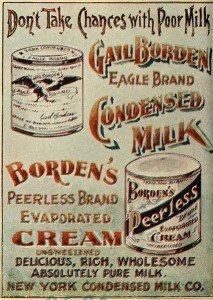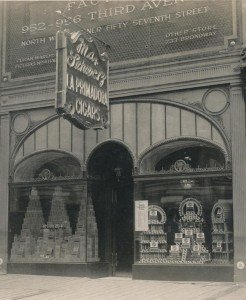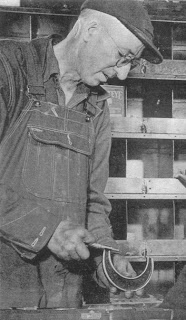 There is a mansion on a large bluff overlooking the Wallkill River Valley. It stands watch over what was once the Borden Farm, center of the Borden Condensed Milk empire. Sweeping views are forever tied to the mansion- from the Hamlet of Wallkill and farm fields, to the Lyon’s Dam on the Wallkill River and the Shawangunk Mountains. It was here that the daughter of John G. Borden, son of the founder of condensed milk, decided to make her home starting in 1900. Read more
There is a mansion on a large bluff overlooking the Wallkill River Valley. It stands watch over what was once the Borden Farm, center of the Borden Condensed Milk empire. Sweeping views are forever tied to the mansion- from the Hamlet of Wallkill and farm fields, to the Lyon’s Dam on the Wallkill River and the Shawangunk Mountains. It was here that the daughter of John G. Borden, son of the founder of condensed milk, decided to make her home starting in 1900. Read more
Labor History
Torcedores: Gothams Hispanic Cigar Rollers at Work
 It now seems hard to believe that for most of the latter part of the 19th century, New York City was the cigar making capital of the United States.
It now seems hard to believe that for most of the latter part of the 19th century, New York City was the cigar making capital of the United States.
New York State as a whole had 364 cities and towns with 4,495 cigar factories and 1,875 (41%) of these were operating in mid and lower Manhattan. The island which then comprised the City, made 10 times the number of cigars as Havana, Cuba.
At the city’s peak before WWI and the beginning of the Machine-Age, approximately 3,000 factories, including many of America’s largest, rolled cigars in Manhattan. Read more
Free Love: Emma Goldman and Victoria Woodhull
Victoria Woodhull 1828-1927
Love was too important to be left in the hands of the state, thought Victoria Woodhull. And she said so, at Steinway Hall just off Union Square in New York City in 1871, speaking to a packed audience on the principle of “social freedom,” the code word for the right to choose your sexual partners.
“Yes, I am a free Lover, I have an inalienable, constitutional and natural right to love whom I may, to love as long a period as I can, to change that love every day if I please.” The audience went wild. Read more
Peter Feinman On New Yorks Ruin Porn
Ruin porn is in. Ruin porn is hot. Ruin porn is sexy. Ruin porn is the term coined by Jim Griffioen, who writes a blog about his life as a stay-at-home dad in Detroit.
As part of that effort he periodically posts photographs he has taken of the more than 70,000 abandoned buildings in his city. Such images included (as reported in the New York Times) “‘-feral’ houses almost completely overgrown with vegetation- a decommissioned public-school book depository in which trees were growing out of the piles of rotting textbooks”. The term has become a familiar one in the city not without some misgivings by the locals as they watch tourists take souvenirs of their city back home. Read more
Northern New York Survival Stories
 I recently covered some pretty tough hombres from Lyon Mountain in far upstate New York. Rugged folks, for sure, but by no means had they cornered the market on regional toughness. Here are a few of my favorite stories of Adirondack and North Country resilience. Read more
I recently covered some pretty tough hombres from Lyon Mountain in far upstate New York. Rugged folks, for sure, but by no means had they cornered the market on regional toughness. Here are a few of my favorite stories of Adirondack and North Country resilience. Read more
Swedish Lyon Mountain Mining Oral History
 Last week’s subject, iron miner George Davies (1892–1983) of Standish and Lyon Mountain, was a kindly gentleman with a powerful work ethic and a can-do, pioneer spirit. Interviews with him in 1981 were key to my second book, Lyon Mountain: The Tragedy of a Mining Town. Humble and matter of fact, he shared recollections from nearly 80 years earlier. Read more
Last week’s subject, iron miner George Davies (1892–1983) of Standish and Lyon Mountain, was a kindly gentleman with a powerful work ethic and a can-do, pioneer spirit. Interviews with him in 1981 were key to my second book, Lyon Mountain: The Tragedy of a Mining Town. Humble and matter of fact, he shared recollections from nearly 80 years earlier. Read more
Lyon Mountain Mines: George Davies of Clinton County

George Davies of Standish in Clinton County was about as tough an Adirondacker as you’ll find anywhere. Standish was the sister community to Lyon Mountain during its century-long run of producing the world’s best iron ore. Davies (1892–1983) was among the many old-timers I interviewed around 1980 for my second book, Lyon Mountain: The Tragedy of a Mining Town. He was kind, welcoming, and honest in describing events of long ago.
George was a good man. The stories he told me seemed far-fetched at first, but follow-up research in microfilm archives left me amazed at his accuracy recounting events of the early 1900s. His truthfulness was confirmed in articles on items like strikes, riots, injuries, and deaths.
When I last interviewed George in 1981 (he was 88), he proudly showed me a photograph of himself as Machine Shop Supervisor in the iron mines, accepting a prestigious award for safety. I laughed so hard I almost cried as he described the scene. George, you see, had to hold the award just so, hiding the fact that he had far fewer than his originally allotted ten fingers. He figured it wouldn’t look right to reveal his stubs while cradling a safety plaque.
In matter-of-fact fashion, he proceeded to tell me what happened. Taken from the book, here are snippets from our conversation as recorded in 1981: “I lost one full finger and half of another in a machine, but I still took my early March trapping run to the Springs. I had a camp six miles up the Owl’s Head Road. While I was out there, I slipped in the water and nearly froze the hand. I had to remove the bandages to thaw out my hand, and I was all alone, of course. It was just something I had to do to survive.
“When I lost the end of my second finger in an accident at work, I was back on the job in forty-five minutes. Another time I was hit on the head by a lever on a crane. It knocked me senseless for ten minutes. When I woke up, I went back to work within a few minutes. [George also pointed out that, in those days, there was no sick time, no vacation time, and no holidays. Unionization was still three decades away, and the furnace’s schedule ran around the clock.]
“When I started working down here, the work day was twelve hours per day, seven days a week, and the pay was $1.80 per day for twelve hours [fifteen cents per hour] around the year 1910. That was poor money back then. When they gave you a raise, it was only one or two cents an hour, and they didn’t give them very often.
“In one month of January I had thirty-nine of the twelve-hour shifts. You had to work thirty-six hours to put an extra shift in, and you still got the fourteen or fifteen cents per hour. It was pretty rough going, but everybody lived through it. Some people did all right back then. Of course, it wasn’t a dollar and a half for cigarettes back then [remember, this was recorded in 1981].
“Two fellows took sick at the same time, two engineers that ran the switches. They sent me out to work, and I worked sixty hours without coming home. Then the boss came out to run it and I went and slept for twelve hours. Then I returned for a thirty-six hour shift. No overtime pay, just the rate of twenty-five cents per hour.” Now THAT’s Lyon Mountain toughness.
The tough man had also been a tough kid. “When I was thirteen years old, I worked cleaning bricks from the kilns at one dollar for one thousand. On July 3rd, 1907, when I was fifteen, I accidentally shot myself in the leg. I stayed in Standish that night, and on the next day I walked to Lyon Mountain, about three miles of rough walking.”
His father was in charge of repairing the trains, and young George climbed aboard as often as he could. “I was running those engines when I was sixteen years old, all alone, and I didn’t even have a fireman. I always wanted to be on the railroad, but I had the pleasure of losing an eye when I was nine years old. I was chopping wood and a stick flew up and hit me in the eye.
“I pulled it out, and I could see all right for a while. Not long after, I lost sight in it. The stick had cut the eyeball and the pupil, and a cataract or something ruined my eye. The doctor wanted to take the eye out, but I’ve still got it. And that’s what kept me off of the railroad. That was seventy-nine years ago, in 1901.”
Next week: A few of George Davies’ remarkable acquaintances.
Photo: George Davies.
Lawrence Gooley has authored 11 books and more than 100 articles on the North Country’s past. He and his partner, Jill McKee, founded Bloated Toe Enterprises in 2004. Expanding their services in 2008, they have produced 32 titles to date, and are now offering web design. For information on book publishing, visit Bloated Toe Publishing
The Railroad Wars of New York State
 New York’s railroads were born of the cutthroat conflict of rate wars, bloody strikes and political graft. The railroad wars began as soon as the first line was chartered between Albany and Schenectady when supporters of the Erie Canal tried to block the new technology that would render their waterway obsolete.
New York’s railroads were born of the cutthroat conflict of rate wars, bloody strikes and political graft. The railroad wars began as soon as the first line was chartered between Albany and Schenectady when supporters of the Erie Canal tried to block the new technology that would render their waterway obsolete.
After the first primitive railroads overcame that hurdle, they began battling with one another in a series of rate wars to gain market share. Attracted by the success of the rails, the most powerful and cunning capitalists in the country—Cornelius Vanderbilt, Jay Gould, Daniel Drew and other robber barons—joined the fray. Read more
Dolly Sloan and The Lawrence Strike Children in NY
Artist John Sloan is better known but his wife Dolly was a tireless campaigner for causes in the Village. Sloan’s diaries are full of vignettes describing her buzzing off to demonstrations for the Socialist Party, the International Workers of the World (IWW), and Suffrage. He seems to be following her, and soaking up the atmosphere, more than out there professing his beliefs.
However, Sloan supported votes for women and rights for workers, and drew illustrations for such left wing publications as The Call. Read more
1934: A New Deal for Artists Exhibit in Albany
 During the Great Depression, President Franklin Delano Roosevelt promised a “new deal for the American people,” initiating government programs to foster economic recovery. Roosevelt’s pledge to help “the forgotten man” also embraced America’s artists.
During the Great Depression, President Franklin Delano Roosevelt promised a “new deal for the American people,” initiating government programs to foster economic recovery. Roosevelt’s pledge to help “the forgotten man” also embraced America’s artists.
The Public Works of Art Project (PWAP) enlisted artists to capture “the American Scene” in works of art that would embellish public buildings across the country. They painted regional, recognizable subjects – ranging from portraits, to cityscapes and images of city life, to landscapes and depictions of rural life – that reminded the public of quintessential American values such as hard work, community and optimism. Read more

